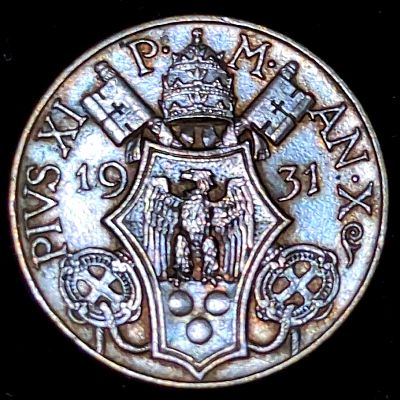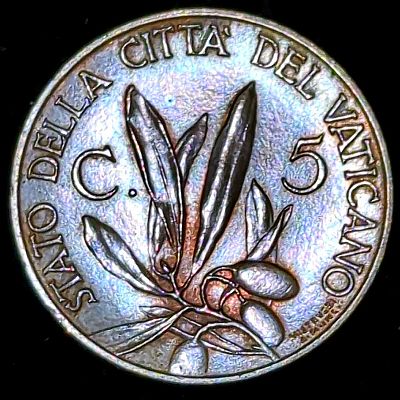The first coin from the new Vatican City State

I recently shared an 1866 Papal States 2 Soldi, one of the last coins issued by the Papal States before the (then fairly new) Italian Kingdom invaded the vatican and seized the lands formerly controlled by the pope. Do read that post for more info on that incredible time in history. Following 1870, the Pope remained in charge of the Holy See, and as head of the church.
The “Holy See” is, simplistically, the jurisdiction of the Pope in his role as the bishop of Rome. This was founded in the first century by Saints Peter and Paul. During that time, Rome was the centre of the Roman Empire, although the church wasn’t formally recognised by a Roman Emperor until Constantine the Great in 313 A.D. It became the official state church in 380 A.D. under Theodosius I.
From 1870, although the Pope was “A prisoner in the Vatican“, he was still able to build relations with other countries. In 1929, the Lateran Treaty was signed between the Kingdom of Italy and the Holy see. This recognised Vatican City State (often shortened to “Vatican City” or simply “The Vatican”) as independent City-state. Today, there are only three internationally-recognised City-states: Vatican City, Singapore, and Monaco.
Free to run its own affairs, Vatican City started minting its own coins in 1929. Among the first series, the smallest coin was the 5 Centesimi. The obverse, featuring the coat of arms of Pius XI, is shown above.

The reverse, shows the new city-state’s name in Latin, as well as the value, and an olive branch, symbolic of the peace which had been restored between the Holy See and Italy.
Another less visible, but interesting thing about this coin is that it is the Vatican City’s KM #1 coin. KM Numbers refer to the Standard Catalog of World Coins, originally written by Krause and Mishler. The author’s names are the origin of KM. Basically, for any country, the earliest date and smallest denomination has the lowest KM number. The numbers advance by first date of type and then by denomination. So this 5 Centesimi is was first issued in the first year this country issued coins (1929), and it is the smallest denomination that was issued that year. It can be interesting to collect KM1 coins.
Having a universal catalog makes it easier for numismatists around the world to know they are talking about the same coin. This 5 Centesimi is the ONLY coin designated KM #1 from Vatican City. KM numbers for some countries are very high. This 1952 10 Groschen from Austria is KM #2878. The KM number does not change while the design of a coin remains the same. That Austrian 10 Groschen was issued from 1951 – 2001 and had the same KM number the whole time. This 5 Centesimi was issued from 1929 – 1938, and retained the same KM number during that time. Pope Pius XI died in February 1939. Later that year, a new series of coins bearing the coat of arms of his successor, Pope Pius IX were issued. The 5 Centesimi had the same reverse design, but as the coat of arms had changed, it got a new KM number (KM #22 by this time).
Unfortunately the parent company to Krause, who manufactured the Standard Catalogue of World Coins went bankrupt in 2019. No new editions have been released since then, and it is unclear what will happen to the coin referencing system moving forward. What do you think? Let us know in the comments!


Leave a Reply